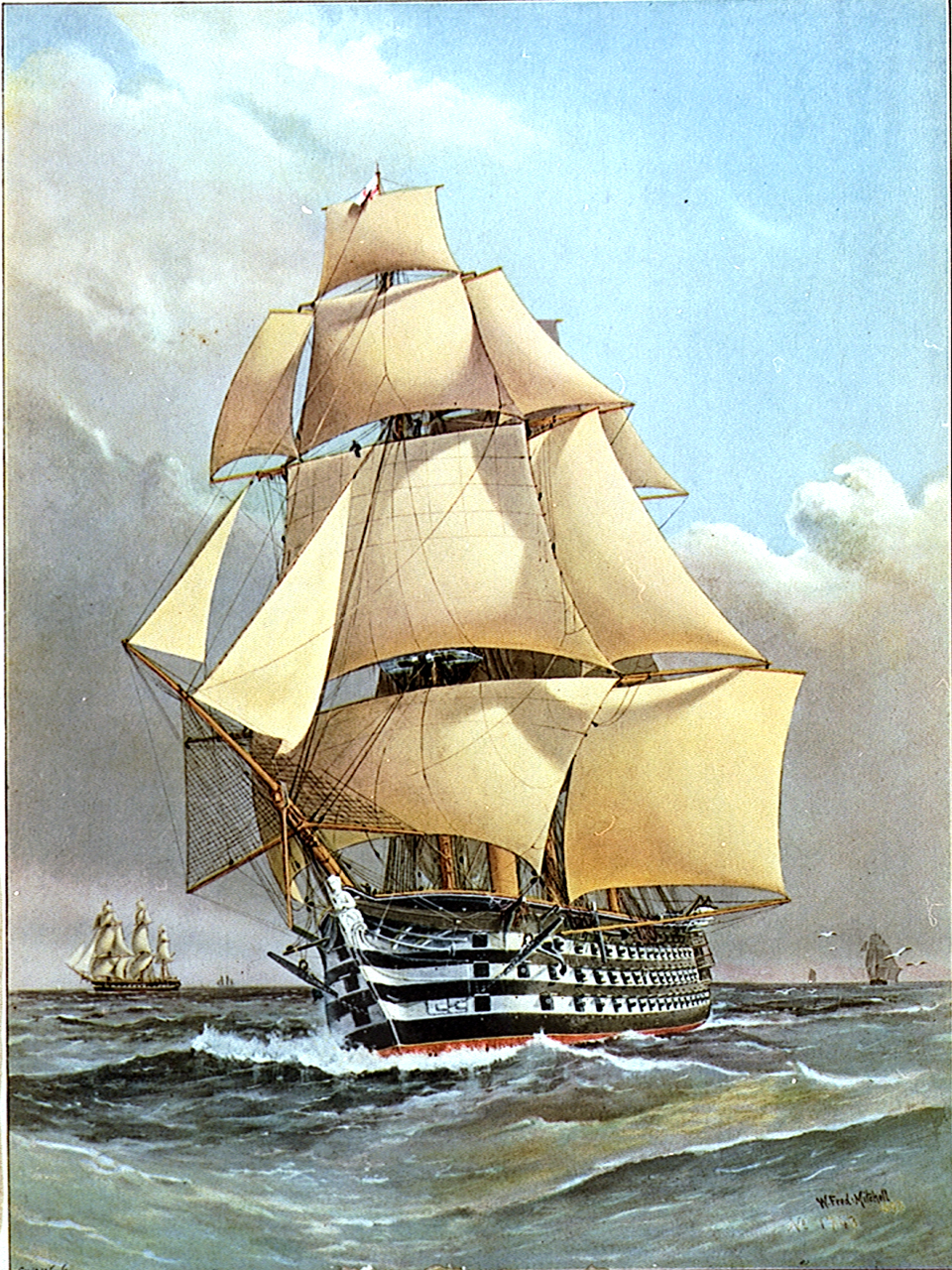
HMS Victoria, painting by William Frederick Mitchell, 1898
The two-funnelled Victoria combined up-to-date and traditional features. Despite powerful engines it carried a full spread of sail. Note also the stern galleries.
With its sister ship Howe, Victoria was the last wooden-hulled three-decker to be built for the British Navy. Already obsolescent despite its steam propulsion, it had an active life of less than 10 years.
It was an era of distinct change. The last sail-driven ships of the line were ordered for the Royal Navy as late as 1848 (the 80-gun Orion class). Lord Auckland, First Lord of the Admiralty 1846–49, had defined the new requirement for design: ‘…the manner in which the screw auxiliary may be best combined with good sailing qualities.’
The Crimean War of 1854–56 was a long-distance war for France and even more so for Britain, requiring transport through the Mediterranean and into the Black Sea. Steam propulsion, with its speed and independence of the wind, really came into its own. But the Royal Navy still had relatively few steam-powered warships and a hurried programme of conversion began. Victoria however was planned from the start as a steamship. In the British Admiralty’s typical knee-jerk response to French developments, it was intended to rival the 130-gun French three-decker Bretagne, which had been laid down as a sailing ship but was converted to steam propulsion while building, and launched in February 1855.
Victoria was laid down at Portsmouth on 1 April 1856 and launched on 12 November 1859. It was a hybrid, a traditional wooden-hulled three-decker of 121 guns with steam engines, and cost £150,578. Eight boilers were arranged laterally in four pairs with the engine between, and it was the Royal Navy’s first two-funnelled warship. The hull was heavily strapped on the inner side with diagonal iron riders, 127mm (5in) wide and 25mm (1in) thick, to hold the planking together against the vibrations from machinery and screw. Even so, the seams tended to separate and it was a leaky ship. Quite apart from the superior shell-resistance of iron, the problems arising from powerful machinery and heavyweight guns in a wooden hull encouraged the use of iron in construction. Victoria was the largest wooden-hulled battleship ever built, and was briefly absolutely the largest, until the arrival of HMS Warrior. The early engines were bulky, and the weight of machinery, low down in the hull, enabled builders to greatly reduce the amount of ballast carried, or even dispense with it altogether, as in the 101-gun HMS Conqueror (1855). But captains had to learn how to trim their ships as the coal bunkers gradually emptied. Victoria and Howe were both very fast ships for their time; on trials Victoria made 11.79 knots and Howe achieved 13.56 knots though neither was carrying anything like a full load.
Victoria has been described as ‘the acme of the three-decker’, at twice the tonnage of HMS Victory, and with a far higher destructive capacity. A 68-pounder chase gun was mounted in the bow to give forward fire, and the 200mm (8in) and 30-pounder guns were fitted with sights to enable accurate fire at ranges of at least 1097m (1200yd). These guns fired explosive shells which penetrated wood planking and then burst.
Better sighting and longer range also made greater dispersion of fire possible, so that Victoria could direct fire at more than one target at a time. As a result of this, tactics for naval battles were being revised, and within two years the giant three-deckers were acknowledged as obsolescent, when the House of Commons voted in April 1861 to end the construction of wooden-hulled capital ships. This did not lead to the immediate abandonment of the wooden steam-powered men of war, but major refits stopped, and by the end of the 1860s they were out of use.
From 1860 to 1864, Victoria was held in reserve at Portsmouth, then from 1864, with the number of guns reduced to 102, was flagship of the Mediterranean Fleet, with its main stations at Gibraltar and Malta. The last time the great wooden-hulled ships went on parade was at the Spithead Naval Review of July 1867, before Queen Victoria and the Ottoman Emperor.
In August 1867 Victoria was paid off, and technically returned to reserve status, but in fact the old wooden vessels were either converted to other uses or left to rot away. Another HMS Victoria was launched in 1887, claimed as the most powerful ironclad in any navy, by which time the old Victoria was disarmed. The hull was sold for scrap in May 1893. A month later the new HMS Victoria was sunk in a collision with HMS Camperdown during drill manoeuvres.
Victoria’s 200mm (8in) guns fired explosive shells. Although these had been in use for some 20 years, they had not proved to be as devastating a weapon as their inventor Joseph Paixhans had supposed, often failing to detonate due to faulty fuses. Shell-fire was more effective in theory and in target practice at this time than in combat. Perhaps more dangerous for a wooden-hulled ship was red-hot cannon balls. These were frequently used by Russian shore forts in the Crimean War and, and from 28 February 1854, the Royal Navy’s steam-powered ships were equipped with furnaces and handling gear for firing red-hot shot. Of course this required very careful handling, and only 32-pounder guns of the most robust construction were considered really safe to fire them. Until 1860 British naval guns were, as they had always been, of smooth-bore muzzle-loading type, but it was evident that these were, or very soon would be, outdated. The problem was what to replace them with.
Specification
Dimensions: Length 79.2m (260ft), Beam 18.3 (60ft), Draught maximum 7.8m (25ft 9in), Displacement 6313 tonnes (6959 tons)
Propulsion: Maudslay 3283kW (4403hp), single screw; 3 masts, full ship rig
Armament: 62 200mm (8in), 32 30-pounder, 36 32-pounder, 1 68-pounder
Speed: 11.79 knots on trials
Complement: 1000